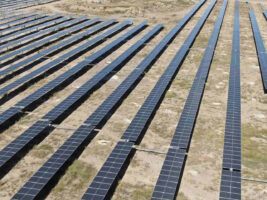Australia is now on track to meet its renewable energy target of 33,000GWh by 2020, Australia’s Clean Energy Regulator has said, driven largely by the current burst of growth in the large-scale solar market.
Jay Hender, the Regulator’s general manager of technical assessment and support, said that while building another 6000MW of installed renewable energy capacity between now and 2020 remained a “significant task”, activity in Australia’s renewables sector was mounting by the week.
“We had a very slow start to 2016, which built up to big action in the last quarter, leading into the beginning of (2017),” Hender told the 2017 Large-Scale Solar Conference co-hosted by RenewEconomy and Informa on Monday. He said that 2,000MW of wind and solar had been committed in 2016, and this trend continued into 2017, with another 1GW of commitments.
“We’re tracking pretty well, I would say, for this point in time.”
Hender pointed to the big uptick in large-scale solar activity, that gained momentum at the end of 2016 and was continuing to do so this year, as a big driver of this progress.
Big solar has become a bigger and bigger portion of new installed capacity, and is currently sitting at around 50:50 with wind, Hender said.
“That’s a pretty big change over a short period of time,” he added.
And he said the quieter achievements of Australia’s commercial solar sector – big solar’s “poor little cousin” – was also an increasingly important contributor to the 2020 target.
“(Here) you’ve got large, significant energy consumption during the day, and large roof space,” he said, noting the largely untapped potential of the commercial and industrial solar sector.
“In essence there’s been a doubling of the capacity of (commercial solar) projects, year on year, year on year.
“You don’t have to be a mathematician to know that … amounts to exponential growth. From big things little thing grow,” he said.
Bloomberg New Energy Finance associate Leonard Quong warned that despite this new build, shortfalls could be expected in LGC deliveries in 2018, keeping LGC prices at near penalty prices and maintaining pressure on politicians about the “cost of renewables”, even though the actual cost of the technology continued to fall.
This meant it was essential that the government maintained policy certainty – something that the industry has so far been unable to rely upon.
“(One) source of revenue that should be questioned is LGCs,” Quong said. “Political and policy intervention and commitment have a very real impact on (LGC) pricing.
“The 2014 RET Review saw prices collapse to the lowest on record, near $20, that caused an investment freeze. We saw a 90 per cent drop in large-scale investments over an 18 month period, and now we simply don’t have enough capacity coming on to meet liabilities.”
Meanwhile, the “fundamental cue” for LGC pricing – the electricity – had an equally uncertain outlook, said Quong.
While the Coalition had committed to its revised renewable energy target, he said, it was not inconceivable that this position might become “politically unpalatable”, if LGC prices remained high due to a projected shortfall in certificates in 2018.
“Although we’ve heard statements from the energy minister and prime minister himself that the LRET… is set in stone, the very real challenges faced more broadly by the energy market could undermine that pledge,” he said.
Quong was also confident about the growth of solar PV, noting that his organisation has “consistenly underestimated the market,” as costs plummeted by 90 per cent since 2009.
“We have continually had to increase our forecast,” Quong said. “We have never once had to decrease expectations.”
But while big solar growth continued to be “exceptional,” BNEF’s outlook on the progress of the RET was not quite as positive as CER’s.
“It’s a rosy picture,” Quong told the conference, “but there are caveats.”
Chief among those caveats, he said, would be continued policy certainty – something that the industry has so far been unable to rely upon.
“We feel that one of the major problems right now… is managing a lack of policy certainty, and revenue risks imposed by the current market.
“(One) source of revenue that should be questioned is LGCs…
“Political and policy intervention and commitment have a very real impact on (LGC) pricing,” Quong said.
“The 2014 RET Review saw prices collapse to the lowest on record, near $20, that caused an investment freeze. We saw a 90 per cent drop in large-scale investments over an 18 month period, and now we simply don’t have enough capacity coming on to meet liabilities.”
Meanwhile, the “fundamental cue” for LGC pricing – the electricity – had an equally uncertain outlook, said Quong.
While the Coalition had committed to its revised renewable energy target, he said, it was not inconceivable that this position might become “politically unpalatable”, if LGC prices remained high due to a projected shortfall in certificates in 2018.
“Although we’ve heard statements from the energy minister and prime minister himself that the LRET… is set in stone, the very real challenges faced more broadly by the energy market could undermine that pledge,” he said.
For more on this subject: Renewable certificate prices fall despite looming shortfall













